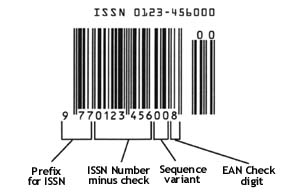About barcodes in newspapers
The barcode symbols that appear on the cover of magazines and newspapers are the same type of barcodes that are on all retail products. However, although the simbology is the same, the numbering system used to generate the barcode is different. The EAN for normal retail products is a 13 digit number which uniquely identifies that product, however a periodical already has a unique number to identify it, the ISSN (provided by the National Serials Data Centre). The EAN barcode for a magazine or newspaper is generated from the ISSN for the periodical.
The ISSN consists of two blocks of four numbers separated by a hyphen, and this is what the Miles33Barcode object will write over the barcode proper: 1234-5678 (if a title is requested). The structure of a barcode is the following:

The components are:
-ISSN Prefix: 977 is reserved to signify an ISSN code.
-ISSN Number: The first seven digits provided by ISSN, minus the check digit.
-Sequence Variant: Two digits representing any price variation since the previous issue. This is what we call “Price Change”. For daily newspaper, only the first digit identifies the price variation, while the second identifies the day of the week (1: Monday, 2: Tuesday, etc.).
-Check Digit: Mathematical calculation based on the other digits (checksum).
An ISSN also has two digits add-on that don’t enter in the checksum calculation and form an “add-on” barcode. These are used to show the issue number of the publication. This should coincide with the weeks or months of the year when the publication is on sale. On daily newspapers, the add-on is the week of the year.
For further information about the ISSN, please refer to http://www.issn.org/.
